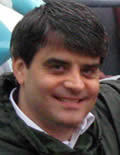
Act like you’ve been there before, insist plainclothes football coaches in the Joe Paterno and Lou Holtz mold, sounding like people who saw the fall of civilization in Elvis Presley’s swiveling hips. In the 1980s, Miami had never been there before and didn’t pretend otherwise.
With combat fatigues and fighting words, those Hurricanes played the braying renegades to Penn State’s white hats and Notre Dame’s golden halos. It was a calculated insurgency, like the irreverent AFL’s threat to the established NFL standards and practices — and with much the same result. Now college football is all one flavor with different food coloring.
A recent book by my former South Bend Tribune colleague Jeff Carroll — Perfect Rivals: Notre Dame, Miami, and the Battle for the Soul of College Football — traces how the nouveau-riche Hurricanes and old-money Irish became antagonists.
Even in the dregs of the Gerry Faust era, no program compared to Notre Dame in tradition and reputation, but that meant nothing to the Hurricanes, who could talk and run circles around everyone. “Notre Dame was the anti-U,” Miami lineman Leon Searcy says in the book. “They exemplified everything that we weren’t. We looked at Notre Dame as clean-cut, crew-cut, [fancy] sweater wearing, briefcase carrying, representing a society as a whole that we didn’t understand and just didn’t like.”
And vice versa. Perfect Rivals illustrates that the differences were more exaggeration than reality — Miami had an “exemplary” graduation rate under Jimmy Johnson, for example, and Holtz’s recruits included academic risks that were unusual for Notre Dame. “I sensed that there were some rough kids that came in,” longtime director of academic advising Mike DeCicco tells Carroll. “I found that I had to push kids to get to class a little bit more. Actually, more than a little bit.”
In the rivalry’s narrative, though, they were opposites — empire vs. rebel, hero vs. villain, Catholics vs. convicts. That’s showbiz, and both teams embraced their roles. Miami, especially, which is why Carroll had a book to write.
Part of the fun reading Perfect Rivals is in revisiting the personalities who defined that bristling era. It seems like a long time ago that the Hurricanes paraded themselves around with such disregard for protocol that its Fiesta Bowl loss to Penn State prompted an Arizona newspaper to blare, “CLASS BEATS CRASS.”
Is there a coach today who would allow such a “distraction” at the risk of inciting an opponent? One who would tolerate the perma-strut? Cultivate a team personality more controversial than “businesslike”?
Johnson and Holtz were cut from the same competitive cloth, but with different motivational sensibilities. Even though the Woody Hayes disciple would have tolerated none of Miami’s preening, Holtz had enough charisma to give the Irish a certain chin-jutting manner.
Perfect Rivals serves as a reminder that only shards of attitude remain. College football has become interchangeable and formulaic — CSI: Tuscaloosa, Lincoln, Boise. Miami’s still on the air, too, and Notre Dame remains in NBC’s fall lineup, but they’re just faces in the ensemble now, mouthing the same predictable lines as everyone else.
Carroll notes that there are major benefits today despite the sanded edges: more opportunities for small-conference teams, more options for fans. “For sheer fun, however, it will always be difficult to match that period,” and he could have put an exclamation point on that.
Jason Kelly, a former sports columnist for the South Bend Tribune, is an associate editor of the University of Chicago Magazine. His most recent book is Shelby’s Folly: Jack Dempsey, Doc Kearns, and the Shakedown of a Montana Boomtown. Email him at jasonkelly545@gmail.com.